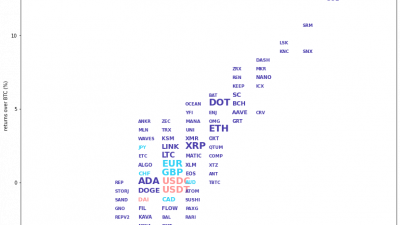
As interest in and use of blockchain accelerates this year, so do regulators’ fears, making them pay more attention to crypto exchanges.
Powers On… is a monthly opinion column from Marc Powers, who spent much of his 40-year legal career working with complex securities-related cases in the United States after a stint with the SEC. He is now an adjunct professor at Florida International University College of Law, where he teaches the course “Blockchain, Crypto and Regulatory Considerations.”
More and more, governments are fearing that they will lose control over aspects of their respective legitimate financial systems, including capital raising and trading, to the hundreds of unlicensed, unregulated centralized and decentralized crypto exchanges worldwide.
There is a clear rising chorus of alarm in statements by government regulators in the United States, England, China, Southeast Asia and elsewhere, which are focused now more than ever on the unregulated exchanges that offer trading of derivatives and spot markets in numerous cryptocurrencies. These efforts follow regulators having tamped down on the rampant initial public offering of cryptocurrencies in the form of initial coin offerings, simple agreements for token contracts, and security token offerings during the 2016–2020 period.
Some of the cryptocurrencies trading on exchanges such as Binance, Poloniex, Coinbase, KuCoin and Kraken — to name a few — are, indeed, currencies in the form of stablecoins. Others are likely securities as defined by United States federal securities laws, under the expansive interpretation of “investment contracts” by U.S. courts and the SEC. Other cryptocurrencies are commodities, such as Bitcoin (BTC) and Ether (ETH). Their futures are one of the few cryptocurrencies traded on licensed U.S. exchanges such as the Chicago Mercantile Exchange and Bakkt.
Related: It is time for the US to create a ‘Ripple test’ for crypto
In some measure, these fears are justified — to the extent that investor protection is compromised by allowing unacceptable risks to investors who may not understand or appreciate the downside of their trading activities. An example of this is margin trading that allows significant leverage based upon only a small deposit of funds or tokens in an account. Binance, until recently, allowed 125x leverage on futures purchases of Bitcoin. (It reportedly reduced leverage down to 20x in July, presumably due to pressure from various international regulators.) In other words, if you had $10,000 in assets in your account, you could purchase up to $1.25 million worth of cryptocurrencies! That is insane leverage, filled with potential problems for both the exchange and the customer.
Given the extreme volatility in the prices of various cryptocurrencies, this could be a major problem for the customer if prices drop and they are forced to come up with adequate reserves for their account. If they do not have the funds, their positions will be liquidated by the exchange, which will likely result in substantial losses for the account. There might be a large debit balance created in the account.
Broker-dealers, disintermediation and the securities laws
The exchange has to fulfill the trades ordered by customers, and even with liquidations, it might be stuck with the customer’s losses if they do not have the funds. In periods of market disarray, this can have a cascading effect on various exchanges worldwide. All one has to do is remember the 2008–2009 financial crisis, which was brought about in part by the failure of Lehman Brothers. Here in the U.S., most retail customers can not leverage more than 60% to 75% of their account’s value. That’s not even 1x. The U.S. Federal Reserve’s Regulation T and Financial Industry Regulatory Authority’s margin rules require licensed brokers to monitor the extent of customer leverage to ensure it does not exceed a certain level.
Related: Broker licensing for US blockchain developers threatens jobs and diversity
There are also net capital rules for brokers, known technically as “broker-dealers” under securities laws, which require them to maintain a certain level of capital representative of the asset value of their customer account. These rules seek to ensure that they maintain minimum levels of liquid assets and are set forth in Rule 15c3-1 promulgated under the Securities Exchange Act of 1934. If the SEC-registered broker-dealer holding the customer’s assets in an account goes out of business, there is up to $500,000 in Securities Investor Protection Corporation, or SIPC, insurance to protect the customer’s account. Worse, there are continuous efforts by criminals to hack these platforms and steal investor funds.
Moreover, some exchanges — not likely the ones mentioned above — may unknowingly allow market participants to engage in trading patterns or activities that are manipulative. Many such manipulative practices are defined and prohibited by statute, in Sections 9(a)(2) and 10(b) of the Exchange Act. These include spoofing, front-running and insider trading.
What is fascinating to me about all this is the fact that blockchain “disintermediation,” the mantra of crypto enthusiasts and supporters, is here — at least for the brokerage community. The buying and selling of crypto are occurring directly by the customer with the exchange, with no broker in between to facilitate the trade. The middleman has been cut out of the process. There is no broker to check on the suitability of the trading activity — no broker to be there to hold and protect the digital assets. These digital assets are held directly with the exchange where one trades or delivered out to a personal digital wallet of the investor. If the exchange fails, the investors could lose everything. There is no SIPC to reimburse the investor. Nor, as of now, is there any federal or countrywide regulator to examine the books and records of the exchange, to receive reports on the financial health and activities of the firm, or to ensure liquidity and that it is not allowing what most people consider bad behavior, such as market manipulation and insider trading.
Yes, Coinbase and Gemini have BitLicenses issued by the New York State Department of Financial Services to operate a crypto exchange, and other licenses by regulators for the various businesses of their subsidiaries and affiliates. And that state agency’s crypto group has supervisory and examination rights. but the size of that group of maybe a dozen or two dozen people pales in comparison to the size of a federal regulator like the SEC, which has over 4,500 employees. Also, many other centralized and decentralized exchanges are not regulated. Thus, many of the safeguards for our financial system and investors, which have been the responsibility of the brokers, are now missing. Nor do the exchanges have any single country of globally consistent requirements like net capital rules, anti-manipulative prohibitions, margin rules and suitability rules to protect investors. Organizations like Global Digital Finance is one organization, of which I am a member, which is seeking to establish these protocols and rules globally working with regulators in over 30 jurisdictions. And yes, these exchanges also may have Know Your Customer and Anti-Money Laundering compliance efforts on their own, but that is more to comply with the Bank Secrecy Act and the Financial Crimes Enforcement Network to stop criminal money laundering and terrorism, not to protect investors on their platforms.
Related: DeFi regulation must not kill the values behind decentralization
Crypto exchanges are under close watch
It is no wonder, then, that Binance has been the target of the Financial Conduct Authority (FCA) in the United Kingdom and of other countries in Europe and Asia — or that the new SEC chairman, Gary Gensler, is voicing concerns. Back in late June, the FCA ruled that Binance was operating an unregistered exchange for U.K. citizens. Following that announcement, a number of British banks stopped allowing their client accounts to send funds to Binance or buy crypto using credit cards.
Related: Binance in the crosshairs: Are regulators paying attention to crypto?
According to May reports, the exchange is also under investigation by the U.S. Justice Department and IRS, which may be looking into money laundering violations and tax offenses. It is also an ominous sign that the former acting comptroller of the currency, Brian Brooks, resigned from his position as CEO of Binance.US after only four months. Knowing Brooks, I speculate that his departure arose because he was not willing to put his reputation on the line for an organization that he found beyond redemption and that flouted numerous rules and regulations of various countries.
Related: DEXs could see demand boost as regulators target centralized exchanges
Another centralized exchange, BitMex, was sued by the U.S. Commodity Futures Trading Commission and FinCen last year in federal court for allegedly operating an unregistered derivatives exchange from 2014 through October 2020 that allowed American residents to trade crypto futures. According to an Aug. 10 press release, BitMEX has agreed to settle the charges and pay a $100 million civil monetary penalty.
On Aug. 9, the SEC announced it had commenced and simultaneously settled an administrative proceeding against the centralized exchange Poloniex, which agreed to pay over $10 million in disgorgement, interest and civil penalties. The settlement order alleges that Poloniex’s trading platform met the definition of “exchange” under federal securities laws and its failure to register as a “national securities exchange” was in violation of Section 5 of the Exchange Act (not to be confused with Section 5 of the Securities Act of 1933, which involves unregistered offerings of securities). Of note in the order is that Poloniex followed the industry practice of seeking out a legal memorandum from a third-party law firm analyzing whether any of the tokens seeking to list on the exchange were “investment contracts” or securities, and even delisted some tokens in 2018 that seemed to pass the Howey test. In addition, SEC Commissioner Hester Peirce wrote, effectively, a public dissent, noting the slow pace and lack of clarity with which the commission has moved in determining how entities can interact with crypto.
Also this month, the SEC went after a purportedly decentralized exchange called DeFi Money Market, which used smart contracts and issued two kinds of tokens. One of the tokens, issued by the company Blockchain Credit Partners, promised interest payments, and the other promised voting rights and a portion of the profits from the exchange’s activities. Fraud charges were based upon the company and its principals allegedly misrepresenting what assets would be used to pay the promised yield. In settling the action on Aug. 6, the SEC stated: “Here, the labeling of the offering as decentralized and the securities as governance tokens did not hinder us from ensuring that DeFi Money Market was immediately shut down and that investors were paid back.”
While it seems that DeFi Money Market did not operate in the same way as many decentralized exchanges out there, it might be advisable that any platforms that solicit U.S. investors do a thorough analysis with their counsel of any potential registration issues — among them, registration as an exchange, broker-dealer, investment adviser, custodian, money transmitter or issuer under various laws. Otherwise, one may find themself in the crosshairs of governments and their regulatory bodies — or worse, criminal authorities. In this regard, it would be worth reviewing the first SEC case against a crypto exchange, EtherDelta, from November 2018.
This article does not contain investment advice or recommendations. Every investment and trading move involves risk, and readers should conduct their own research when making a decision.
The opinions expressed are the author’s alone and do not necessarily reflect the views of Cointelegraph nor Florida International University College of Law or its affiliates. This article is for general information purposes and is not intended to be and should not be taken as legal advice.
Go to Source
Author: Marc Powers



